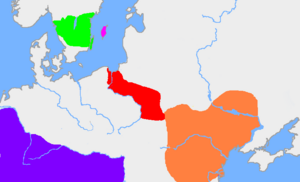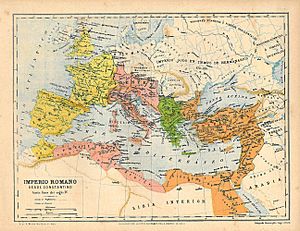Ermanaric facts for kids
Quick facts for kids Ermanaric |
|
|---|---|
| King of the Goths | |
| Reign | c. 296–376 |
| Successor | Vithimiris |
| Born | c. 291 |
| Died | 376 (Aged about 85) |
| House | Amali dynasty |

Ermanaric (died 376) was a powerful Gothic king. He ruled a large area of land before the Huns arrived. This land was called Oium, which was part of Scythia.
Ermanaric is mentioned in old Roman writings. These include texts by Ammianus Marcellinus and the historian Jordanes. He also appears in many exciting Germanic heroic legends. These stories often show him as a legendary figure.
Historians today have different ideas about how big Ermanaric's kingdom was. Some believe it stretched from the Baltic Sea to the Black Sea. It might have even reached the Ural Mountains. Other historians are not so sure. They think such a huge empire would have left more clues.
Contents
What's in a Name?
Ermanaric's name comes from old Germanic words. The first part, Ermena-, means 'universal'. The second part, -ric, means 'ruler' or 'king'. So, his name basically means 'universal ruler'. This was a common part of Gothic royal names.
Ermanaric in Roman History
Ancient Roman writers tell us about King Ermanaric.
Ammianus Marcellinus's Account
Ammianus Marcellinus was a Roman historian. He wrote that Ermanaric "ruled over very wide and rich lands." Ammianus also mentions that after Ermanaric died, a new king named Vithimiris was chosen.
Jordanes's Getica
Another historian, Jordanes, wrote a book called Getica. In it, he says Ermanaric ruled the land of Oium. Jordanes even called him a "Gothic Alexander". He claimed Ermanaric ruled "all the nations of Scythia and Germania as if they were his own."
Jordanes also tells a dramatic story about Ermanaric's death. He says Ermanaric was badly wounded by two brothers, Sarus and Ammius. This happened after Ermanaric had a conflict with their sister. The wounds made him unable to defend his kingdom. This made it easier for the Huns to invade. Jordanes claims Ermanaric was 110 years old when he died.
The story of Ermanaric's injury and death was very popular. It influenced many stories in medieval Germanic literature. This includes tales from England and Scandinavia.
Ermanaric in Legends and Stories
Ermanaric became a famous character in many Germanic heroic legends. These are old stories about heroes and kings.
Norse and Anglo-Saxon Tales
In Norse legends, his name is Jǫrmunrekkr. In Anglo-Saxon stories, he is called Eormenric.
The famous Anglo-Saxon poem Beowulf mentions "Eormenric's tricks and hatred." Another poem, Deor, describes him as a powerful but tricky king. It says he "ruled the people of the realm of the Goths far and wide." It also calls him a "cruel king."
The Legend of Svanhildr
A very important legend involves the death of a woman named Svanhildr. Ermanaric's death then follows at the hands of Jonakr's sons. This dramatic tale is told in many northern European stories.
You can find versions of this story in:
- The Icelandic Poetic Edda and Prose Edda
- The Volsunga Saga
- The Norwegian Ragnarsdrápa
- The Danish Gesta Danorum
- The German Nibelungenlied and Annals of Quedlinburg
Later German Poems
Ermanaric also appears in later German poems. In Dietrichs Flucht, Rabenschlacht, and Alpharts Tod, Ermanaric is the uncle of Dietrich von Bern. He forces Dietrich into exile.
A Low German poem, Ermenrichs Tod, tells a confused version of Ermanaric's death. It is similar to the stories found in Jordanes and Scandinavian legends.
See also
 In Spanish: Hermanarico para niños
In Spanish: Hermanarico para niños
- Berig
- Filimer
- List of longest-reigning monarchs


